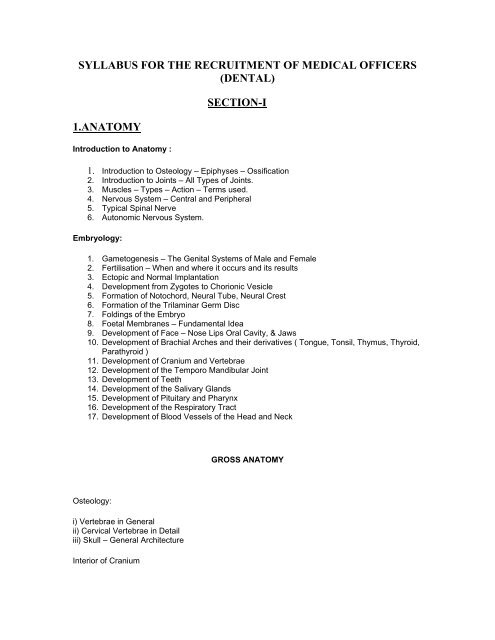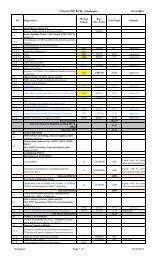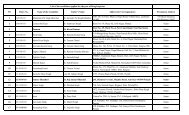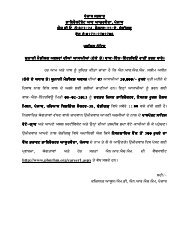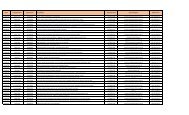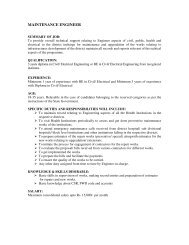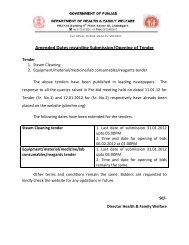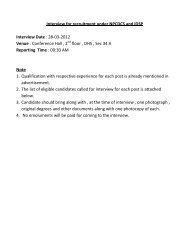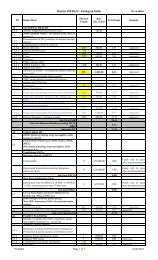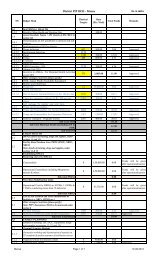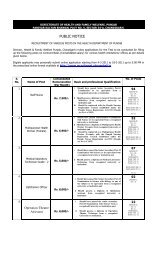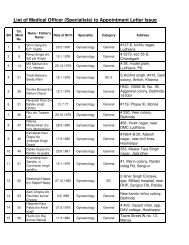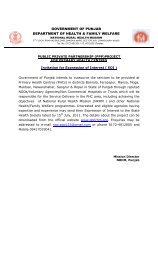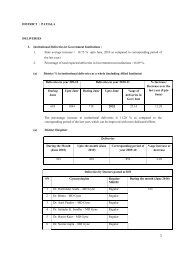syllabus for the recruitment of medical officers (dental)
syllabus for the recruitment of medical officers (dental)
syllabus for the recruitment of medical officers (dental)
You also want an ePaper? Increase the reach of your titles
YUMPU automatically turns print PDFs into web optimized ePapers that Google loves.
36. Vocal cord37. Organs <strong>of</strong> hearing and equilibration38. External ear39. Middle ear40. Internal ear41. Eye ball –42. Spinal Cord – Coverings <strong>of</strong> Meninges43. Contents <strong>of</strong> Vertebral canal44. Gross Anatomy <strong>of</strong> Spinal Cord45. Regional differentiation46. Blood supply47. Main ascending and descending tracts and <strong>the</strong>ir functions48. Joints <strong>of</strong> <strong>the</strong> Neck49. Brain – Meninges50. Subarachnoid Cisterns51. Blood supply <strong>of</strong> Brain52. External surface <strong>of</strong> base <strong>of</strong> brain53. Hind brain – Medulla – Occipital view and cranial nerves attached54. Pons55. Cerebellum – subdivisions and functions56. Fourth Ventricle57. Mid Brain – External View – Cranial nerves attached58. Cerebrum – Main Sulci & Gyri – White matter <strong>of</strong> Cerebrum Lateral Ventricle59. Thalamus – Geniculate Bodies60. Internal Capsule61. Basal Ganglia62. Upper Limb – Names <strong>of</strong> <strong>the</strong> bones & Joints63. Main Artery, Important muscle, nerves & veins64. Thorax – Inlet – Outlet65. Subdivisions66. Lungs and Pleura67. Heart, Pericardium and its blood vessels68. Diaphragm69. Abdomen – Subdivisions70. Location <strong>of</strong> <strong>the</strong> abdominal organs in relation to <strong>the</strong> abdominal wall71. Their blood supply & nerve supplyHistology1. Structure <strong>of</strong> Epi<strong>the</strong>lium – different types – connective tissues fibres and cells2. Bone3. Cartilage4. Muscles5. Blood Vessels6. Lymphatic tissue – Lymph node, tonsil, spleen & thymus7. Alimentary system – Salivary glands8. Oesophagus9. Stomach10. Intestines – Small & Large i.e., Duodenum, Ileum, Jejunum11. Caecum, Appendix, Colon12. Liver, Gall Bladder13. Pancreas14. Reproductive System – Testis, Epididymis, Ductus Deferens15. Prostate,
Dental Porcelain including porcelain fused to metal. Porcelain furnace and fusing.Mechanics <strong>of</strong> Tooth cuttings, burs and pointsAbrasives and polishing agentsDie and Counter die materials including electro-<strong>for</strong>ming and electro-polishingFilling materials <strong>for</strong> anterior teethSECTION-II1.Human Oral Anatomy, Physiology Histology & Tooth Morphologyi) Development and growth <strong>of</strong> face ‘teeth and jaws’ii) Development <strong>of</strong> enamel., dentine, cementum, pulp and periodontal membraneiii) Calcification <strong>of</strong> hard tissues <strong>of</strong> <strong>the</strong> teethiv) Microscopic anatomy <strong>of</strong> hard and s<strong>of</strong>t tissues <strong>of</strong> <strong>the</strong> tooth and surrounding structures.v) Microscopic anatomy <strong>of</strong> hard and s<strong>of</strong>t tissue <strong>of</strong> <strong>the</strong> oral cavity such as lips, tongue, floor<strong>of</strong> <strong>the</strong> mouth, palate, salivary glands, alveolar bones etcvi) Mastication and deglutitionvii) Age changes in teeth and surrounding structuresviii) Shedding <strong>of</strong> <strong>the</strong> deciduous teethix) Eruption <strong>of</strong> permanent teethx) Chronology <strong>of</strong> dentitionxi) Form and arrangement <strong>of</strong> teeth occlusionxii) Functional anatomy <strong>of</strong> <strong>the</strong> oral cavityxiii) Temporomandibular jointxiv) Evolution <strong>of</strong> <strong>the</strong> jaws and teethxv) Chemical composition <strong>of</strong> teethxvi) Calcium phosphorous and fluoride metabolismxvii) Effect <strong>of</strong> hormones on oral tissuesxviii) Influence <strong>of</strong> diet on oral structuresxix) Saliva2.GENERAL PATHOLOGY & MICROBIOOGY1. Introduction to Pathology2. Causes <strong>of</strong> <strong>the</strong> disease3. Cell response to injury4. Inflammatory reactions5. Tissue response to infection6. Wound healing7. Immunity to infection8. Hyper Sensitivity9. Pyogenic infection10. Tuberculosis, Syphilis, Actinomycetes, Leprosy, Fungal & Viral diseases11. Disorders <strong>of</strong> growth12. Haemorrhage and shock13. Disorders <strong>of</strong> nutrition14. Endocrine disturbances15. Disorders <strong>of</strong> calcium metabolism16. Thrombosis and embolism17. Oedema18. Infraction19. Renal failure20. Hepatic failure
21. Pigments22. Calculi23. Healing <strong>of</strong> fractureMICROBIOLOGY1. Basic characteristics <strong>of</strong> microorganisms2. Introduction Bacteriology3. Sterilisation and Disinfection4. Oral Microbial flora5. Staphylococci6. Gram positive and negative bacilli7. Spirochetes8. Actinomycetes9. Viruses10. Organisms causing tetanus and gas gangrene and <strong>dental</strong> caries11. Common parasites12. Vaccines and Sera13. Pyaemia, Septicaemia and Toxaemia14. Culture and Sensitive infection15. Focal and Systemic infection3.GENERAL & DENTAL PHARMACOLOGY & THERAPEUTICS1. General Pharmacology:a. General Principles <strong>of</strong> Pharmacologyb. Drug receptors’ Pharmacodynamicsc. Pharmacokineticsd. Drug bio -trans<strong>for</strong>matione. Dosage <strong>for</strong>ms and routes <strong>of</strong> drug administrationf. Adverse drug reactions2. Drug action on Central Nervous Systema. General Anaes<strong>the</strong>ticsb. Sedatives – Diagnostics and Anti-anxiety Drugsc. AnalgesicsNarcoticsNon-Narcotics (NSAID)d. Anti-epileptic drugse. Analeptics3. Drugs acting on Peripheral Nervous Systema. Cholinergic receptor stimulantsb. Cholinergic receptor antagonistsc. Adrenergic receptor activating drugsd. Local Anaes<strong>the</strong>ticse. Skeletal muscle relaxants4. Anti-infective Agents
a. Sulphonamides & Trimethoprimb. Metronidazole & Tinidazolec. Antibioticsd. Cancer Chemo<strong>the</strong>rapy5.Local anti-infective agentsa. Disinfectants and Antiseptics including anti fungal and antiviral agents6. Drugs acting on Cardiovascular Systema. Drugs in Congestive Cardiac failureb. Anti-hypertensive Agentsc. Vasodilators and Vasoconstrictorsd. Drug <strong>the</strong>rapy <strong>of</strong> shocke. Diuretics7. Drugs acting on Hemopoetic Systema. Iron, Vitamin B12 & Folic acidb. Haemostatic Agents & Anticoagulantsc. Fibrinolytic Agents & Antiplatelet drugs8. Drugs acting on <strong>the</strong> Endocrine Systema. Hypothalamic & Pituitary Hormonesb. Insulin & Anti-diabetic drugsc. Thyroid & Anti Thyroid drugsd. Parathormone, Calcitonin, Calcium & Vitamin De. Adrenocorticosteroidsf. Sex Hormones9. Antacoida. Histamine & Anti-histaminesb. Seratoninc. Prostaglandin10. Drugs acting on Gastrointestinal Tracta. Emetics & Anti Emeticsb. Antidiarrhoealc. Drugs used in constipation11. Drugs acting on Respiratory Systema. Bronchodilatorsb. Antitussive Agents12. Vitamins13. Drugs acting on immune system
14. Miscellaneous Agentsa. Astringentsb. Obtundentsc. Mummifying Agentsd. Stypticse. Disclosing solutionsf. Dentifrices & mouthwashesg. Bleaching agents1. ORAL PATHOLOGY & MICROBIOLOGYSECTION-III1. Aims and objectives 2. Developmental disturbances <strong>of</strong> <strong>dental</strong>, oral and para-oral structureincluding hereditary disorders. 3. Dental caries 4. Pulpal and periapical pathosis and <strong>the</strong>irsequelae 5. Environmental lesions <strong>of</strong> <strong>the</strong> oral and paraoral structures 6. Defence mechanism o<strong>for</strong>al tissues and healing following injuries 7. Diseases or periodontal ligament, gingiva andcementum 8. Effects <strong>of</strong> nutritional disturbances and hormonal disorders on <strong>the</strong> oral and para oralstructures. 9. Infectious diseases <strong>of</strong> oral mucosa 10. Bone disorders affecting jaws 11. Cysts o<strong>for</strong>al cavity 12. Pre-cancerous lesions-etiology and pathology 13. Neoplasms <strong>of</strong> oral cavity 14.Diseases <strong>of</strong> salivary and lymph glands 15. Diseases <strong>of</strong> temporo-mandibular joint 16. Diseases <strong>of</strong>Nerves, Skin blood and <strong>the</strong>ir implications on Oral Tissues 17. Effects <strong>of</strong> radiation on Oral andpara-oral tissues 18. Oral Microbiology.2. GENERAL MEDICINEIntroduction:Aims <strong>of</strong> Medicine, Definition <strong>of</strong> diagnosis, prognosis, treatment, history taking and physicalexaminations <strong>of</strong> a <strong>medical</strong> case. Medical emergencies in <strong>dental</strong> practiceG.I. Disorders:Stomatitis, glossitis, gastritis, Diarrhoea, Amoebiasis, Ascities, mal absorption syndrome.Liver :1. Jaundice, Viral hepatitis, cirrhosis liver, Tender hepatomegaly2. Cardiovascular system:3. Congenital heart disease, classification Rheumatic heart disease, sub-acute bacterialendocarditis. Congestive heart failure. Left Ventricular failure. Hypertension, Coronaryartery disease4. Respiratory system:5. Pneumonia, Bronchitis, Emphysema, Lung Abscess, Eosinophillia Pulmonary Embolism,Pulmonary Tuberculosis, Respiratory failureRenal Diseases:1. Acute Glomerulo Nephritis, Nephrotic Syndrome
2. Haematology:3. Anaemia, Coagulation defects, Bleeding disorders Agranulocytosis. Leukaemia, OralManifestations <strong>of</strong> Haematological disorders, Lymphadenopathy and splenomegaly.4. Central Nervous Systems.5. Meningitis, Facial palsy, Facial pain epilepsy, Headache, Syncope.6. Nutritional and Metabolic:7. Balanced diet-normal daily Protein Caloric malnutrition requirements. Avitaminosis –Diabetes mellitus, calcium homeostasis8. Endocrine Disorders:9. Thyroid Hypo and Hyper10. Pituitary-Hypo and Hyper11. Parathyroid12. Infections:13. Enteric fever-mumps-Viral Exanthomata-Diph<strong>the</strong>ria – Syphilis – Gonorrhoea.14. Miscellaneous:15. Allergy-Drug reactions-Drug interactions – Evaluation <strong>of</strong> a case <strong>for</strong> general anes<strong>the</strong>sia.3.GENERAL SURGERY1. Introduction to Surgery, Surgery especially related to Oro<strong>dental</strong> Surgery, Classification <strong>of</strong>diseases. 2. Inflammation, s<strong>of</strong>t tissue hard tissue-causes, varieties sequelae and treatment. 3.Infections Acute and Chronic, Abscess, Carbuncle Sinus, Fistula, Ulceration Gangrene, Cellulitis,Erysipelas Septicaemia, Pyaemia Toxaemia, Cancrum Oris, Tuberculosis, Syphilis GonorrhoeaActinomycosis, Anthrax, Tetanus. 4. Wounds – complications Treatment, Repair, Asepsis andAntiseptic Measures and procedurewith particular reference to <strong>the</strong> Oral cavity. Haemorrhage and its treatment, haemophilia,Syncope, Shock, Collapse, Head injury – Introduction. 5. Cysts and new growths – Their generalconsideration with special reference to those occurring in <strong>the</strong> Buccal Cavity. 6. Diseases <strong>of</strong> <strong>the</strong>Lymphatic glands especially <strong>of</strong> <strong>the</strong> neck. 7. Outline <strong>of</strong> diseases <strong>of</strong> <strong>the</strong> mouth lips, tongue palate,tonsils and salivary glands. 8. Infections and diseases <strong>of</strong> <strong>the</strong> Larynx, Tracheostomy. 9. Nervoussystem injury to Facial Nerves, paralysis trigeminal Neuralgia 10. Principles <strong>of</strong> Surgical treatment,Dia<strong>the</strong>rmy and radium treatment. 11. Fracture – General Principles <strong>of</strong> treatment, dia<strong>the</strong>rmytreatment 12. Cleft lip and cleft palate. Thyroid and parathyroid. 14. Swellings <strong>of</strong> jaws.4.PREVENTIVE AND COMMUNITY DENTISTRY1. Bio-statistics :Introduction and General Principles <strong>of</strong> Bio-statistics & statistical procedures.2. Psychology:Introduction to Psychological development from birth to adolescence, management <strong>of</strong> child in <strong>the</strong><strong>dental</strong> <strong>of</strong>fice parent counselling in respect <strong>of</strong> <strong>dental</strong> health and hygiene <strong>of</strong> <strong>the</strong> child.3. Public Health:Concept and Philosophy <strong>of</strong> Public Health, Public Health India
General Epidemiology – Health Education, Environmental Health, disposal <strong>of</strong> wastes, waternorms <strong>for</strong> portability purification.4. Preventive Dentistry:Prevention, levels <strong>of</strong> prevention, various measures in <strong>the</strong> prevention <strong>of</strong> <strong>dental</strong> and oral diseaseson individual and mass level5. Public Health Dentistry:Introduction, definition, objectives functions <strong>of</strong> public health dentistry procedural steps in <strong>dental</strong>public health indices <strong>for</strong> <strong>dental</strong> diseases, surveying and evaluation, epidemiology <strong>of</strong> <strong>dental</strong> caries,Periodontal diseases, oral care, public <strong>dental</strong> health programme, school <strong>dental</strong> health program,Dental Health Services <strong>of</strong> State and Centre. Private practice administration, ethics, DentalCouncil and Association. Epidemiology <strong>of</strong> periodontal disease and parameters used in clinicaland population studies.6. Social Sciences:As applied to health, social structure concepts groups, social institutions, urban and ruralsocieties <strong>the</strong>ir concept <strong>of</strong> health. Application <strong>of</strong> sociology in health programmes, socialenvironment.Cultural Anthropology objective different aspects <strong>of</strong> Folk medicine and Popular Medicine, culturalpattern and complexes taboos as related to health.SECTION-IV1.CONSERVATIVE DENTISTRY AND ENDODONTICSDefinition and Scope. Oral Hygiene in relation to conservative dentistry instruments.Nomenclature design and <strong>for</strong>mulae, care and sterilization, examination, diagnosis and treatmentplanning, charting and recording <strong>of</strong> cases, cavities classification and nomenclature, choice <strong>of</strong>filling materials, Principles <strong>of</strong> cavity preparations, control <strong>of</strong> pain, prevention <strong>of</strong> damage to hardand s<strong>of</strong>t tissues during Operative – Procedures, methods employed <strong>for</strong> exclusion <strong>of</strong> saliva Bio-Mechanics <strong>of</strong> cavity design and restoration with filling materials, Pulp and s<strong>of</strong>t tissue protection.Aerators and high-speed equipment, Cavity preparation <strong>for</strong> various types <strong>of</strong> restoration includinginlays and on lays restorative procedures matrices drugs used in <strong>the</strong> conservative dentistry,fractured teeth and <strong>the</strong>ir treatment. Sensitive dentine, its treatment. Ceramics in conservativedentistry.ENDODONTICS:Rationale <strong>of</strong> Endodontic Therapy. Diagnosis in Endodontics, Care and Sterilisation <strong>of</strong>Instruments. Endodontic Treatment <strong>of</strong> Vital and Non-Vital pulp. Tests <strong>for</strong> sterility <strong>of</strong> <strong>the</strong> root canal.Drugs used in root canal <strong>the</strong>rapy. Bleaching <strong>of</strong> Teeth Restoration <strong>of</strong> Endodontically TreatedTeeth. Surgical Treatment in Endodontics.2. ORTHODONTIA1. Definition, aims, objects and scope <strong>of</strong> Orthodontics, Growth and Development <strong>of</strong> jaws teeth,face and skull and establishment <strong>of</strong> normal occlusion. 3. Genetics as applied to Orthodontics 4.
Normal occlusion and its characteristics. Factors responsible <strong>for</strong> establishment and maintenance<strong>of</strong> normal occlusion.5. Malocclusion type & Different classifications. 6. Aetiology <strong>of</strong> malocclusion. 7. History taking andexamination <strong>of</strong> patient and case analysis and differential diagnosis including cephalometrics andtreatment planning. 8. (a) Preventive and interceptive treatment <strong>of</strong> malocclusion (b) Extraction inorthodontics 9. Appliances used in orthodontic treatment – Adequate knowledge <strong>of</strong> (a) removableappliances, Mechanical appliances functional appliances 10. Tissue changes incident toorthodontic treatment. 11. Materials used in orthodontia 12. Habit breaking appliances.3. ORAL MEDICINE (ORAL DIAGNOSIS) AND RADIOLOGYOral Medicine, Oral Diagnosis1. Scope and importance <strong>of</strong> <strong>the</strong> subject. 2. Methods <strong>of</strong> diagnosis including special investigations3. Acute infections <strong>of</strong> Oral and para-oral structures 4. Blood dyscrasias and <strong>the</strong>ir management. 5.Managements <strong>of</strong> Cardiac patient in dentistry. 6. Metabolic and endocrine disturbances and <strong>the</strong>iroral manifestations. 7. Nutritional deficiencies and <strong>the</strong>ir significances in dentistry. 8. Oral sepsisand its effect on general system. 9. Dysfunctions <strong>of</strong> temperomandibular joints. 10. Cervico-faciallymphadenopathy. 11. Diseases <strong>of</strong> salivary glands. 12. Facial pain 13. Cysts and tumour <strong>of</strong> <strong>the</strong>oral cavity. 14. Oral manifestation <strong>of</strong> dermatological and o<strong>the</strong>r systemic disturbances 15. Specialinvestigations 16. Immune concepts <strong>of</strong> oral lesions 17. Forensic odontologyDental Radiology1. Physics <strong>of</strong> radiation – production and properties <strong>of</strong> X-ray. 2. Principles <strong>of</strong> X-ray techniques andfactors <strong>for</strong> Radiography and fluoroscopy. 3. Technique <strong>of</strong> intra-oral and extra- oral Radiographyand normal anatomical land marks 4. Radiological interpretation <strong>of</strong> abnormal <strong>dental</strong> and jawconditions 5. Elements <strong>of</strong> Radiation treatment in oral and facial conditions and <strong>the</strong>ir sequelae 6.Contrast radiography and recent advances in Dental Radiography including radioactive traces.4. PERIODONTIA1. Introduction – Scope and applicability <strong>of</strong> <strong>the</strong> subject. Historical background <strong>of</strong> Periodontology.2. Maintenance <strong>of</strong> Health – Role and Scope <strong>of</strong> Oral Physio<strong>the</strong>rapy measures – patients education– program and periodic check 3. Classification <strong>of</strong> gingival and periodontal disturbances 4.Gingival enlargement5. Infective muco-gingival conditions –specific and non-specific 6. Degenerative conditions –Gingivosis and Periodontosis 7. Atrophic conditions affecting gingival and periodontal tissues 8.Local and systemic factors in <strong>the</strong> causation <strong>of</strong> gingival and periodontal lesions 9. Periodontitisand sequelae 10. Malocclusion, Mal-alignment and traumatic occlusion, Bruxism andTemperomandibular joint disturbances, Occlusal equilibration 11. Diagnosis and diagnostic aidsincluding roentgenography and its uses and limitations 12. Prognosis 13. Morphological defects<strong>of</strong> <strong>the</strong> muco-gingival structures influencing periodontium and <strong>the</strong>ir treatment. 14. Treatment <strong>of</strong> allgingival and periodontal disturbances. Treatment planning phases and rationale. Differentavailable <strong>the</strong>rapeutic procedure. Healing Mechanism 15. Role <strong>of</strong> Nutrition in aetiology andtreatment 16. Drugs in periodontics 17. Instrumentation 18. Splints 19. Preventive periodontics,concept <strong>of</strong> focal infections 20. Materials used in Periodontal5. ORAL SURGERYLocal Anes<strong>the</strong>sia:
1. Introduction 2. Properties <strong>of</strong> an ideal local anaes<strong>the</strong>tic drug 3. Properties <strong>of</strong> common localanaes<strong>the</strong>tic drugs in use 4. Choice <strong>of</strong> anes<strong>the</strong>sia -local or general anes<strong>the</strong>sia 5. Indications andcontra indications, advantages and disadvantages <strong>of</strong> local anes<strong>the</strong>sia 6. Components <strong>of</strong> astandard local anaes<strong>the</strong>tic solution and <strong>the</strong> part played by each component 7. How does a localanaes<strong>the</strong>tic act? 8. Pre-anaes<strong>the</strong>tic medication 9. Technique <strong>of</strong> infiltration anes<strong>the</strong>sia, Nerveblock anes<strong>the</strong>sia Symptoms and signs <strong>of</strong> anes<strong>the</strong>sia 10. Complications associated with localanes<strong>the</strong>sia and <strong>the</strong>ir management.General Anes<strong>the</strong>sia:1. Properties <strong>of</strong> general anaes<strong>the</strong>tic drugs commonly used 2. Pre-anaes<strong>the</strong>tic preparation <strong>of</strong> apatient and pre-medication 3. Evaluation <strong>of</strong> a patient <strong>for</strong> general anes<strong>the</strong>sia 4. Short anes<strong>the</strong>siain a Dental Chair Endotracheal anes<strong>the</strong>sia Intravenous anes<strong>the</strong>sia5. Symptoms and signs <strong>of</strong> general anes<strong>the</strong>sia 6. Complications arising during <strong>the</strong> administration<strong>of</strong> general anes<strong>the</strong>sia and <strong>the</strong>ir management.Exodontia:1 Objectives2 Indications <strong>for</strong> tooth extraction3 Pre-operative assessment4 Forceps extraction5 Surgical extraction (Trans-alveolar extraction)6 Extraction technique under general anes<strong>the</strong>sia in <strong>the</strong> Dental Chair7 Complications <strong>of</strong> tooth extraction and <strong>the</strong>ir managementOral Surgery:1. Definition and scope 2. Diagnosis in oral surgery (a) History taking (b) Clinical examination (c)Special investigation 3. Importance <strong>of</strong> general condition <strong>of</strong> <strong>the</strong> patient in relation to oral surgery.4. Treatment planning 5. Sterilisation 6. Use <strong>of</strong> antibiotics in oral surgery 7. Diagnosis preoperativeassessment and treatment <strong>of</strong> impacted teeth. 8. Pre-pros<strong>the</strong>tic surgery 9. Surgical aidto orthodontics 10. Oro-facial infections, <strong>the</strong>ir diagnosis and treatment 11. Inflammatory diseases<strong>of</strong> jawbone and <strong>the</strong>ir management 12. Diagnosis and management <strong>of</strong> cysts <strong>of</strong> oral cavity 13.Diagnosis and treatment <strong>of</strong> <strong>the</strong> fracture <strong>of</strong> <strong>the</strong> mandible 14. General outline <strong>of</strong> <strong>the</strong> fracture <strong>of</strong> <strong>the</strong>middle third <strong>of</strong> <strong>the</strong> facial skeleton 15. Diagnosis and treatment <strong>of</strong> benign neoplastic lesions <strong>of</strong> <strong>the</strong>oral cavity (Odontogenic and non-odontogenic) 16. Surgical procedure in relation to endodontonic<strong>the</strong>rapy (Apicoectomy) 17. Surgical treatment <strong>of</strong> tumour like lesions <strong>of</strong> <strong>the</strong> oral cavity includingodontome 18. Diseases <strong>of</strong> maxillary sinus with special reference to oro-antral fistula 19.Management <strong>of</strong> haemorrhage in oral surgery 20. Diseases <strong>of</strong> salivary glands, Diagnosis andtreatment <strong>of</strong> salivary glands 21. Surgical aspect <strong>of</strong> histo-pathological diagnosis 22. Oral surgicalcomplications and <strong>the</strong>ir management 23. Diagnosis <strong>of</strong> malignant condition <strong>of</strong> oral cavity, a broadoutline about <strong>the</strong> different methods <strong>of</strong> treatment 24. Diseases <strong>of</strong> temporomandibular joint such asarthritis, hypoplasia, subluxation, dislocation, ankylosis & o<strong>the</strong>r causes <strong>of</strong> inability to open <strong>the</strong>mouth 25. Affliction <strong>of</strong> trigeminal and facial nerves.6. PROSTHODONTICS AND CROWN BRIDGEa) Complete Dentures:1. Introduction and Scope 2. Applied Anatomy 3. Examination, diagnosis, treatment planning andprognosis 4. Principles <strong>of</strong> retention and stability 5. Principles and techniques <strong>of</strong>
impression making 6. Preparation <strong>of</strong> casts, trays and temporary denture bases 7. Jaw relationsand methods <strong>of</strong> registration8. Artificial teeth, <strong>the</strong>ir selection and arrangements and aes<strong>the</strong>tics 9. Articulators and face bows10. Occlusion and articulation in complete dentures 11. Processing and finishing <strong>of</strong> dentures 12.Corrections <strong>of</strong> occlusal discrepancies 13. Delivery and adjustments <strong>of</strong> complete dentures 14.Sequelae <strong>of</strong> ill-fitting dentures 15. Repair, rebasing and relining 16. Immediate denture 17.Implant dentures.b) Removable Partial Dentures:1. Introduction and scope2. Classification3. Examination diagnosis and treatment planning4. Components <strong>of</strong> removable partial denture and <strong>the</strong>ir function5. Surveyors6. Mouth preparations <strong>for</strong> partial dentures7. Impression procedures8. Designs <strong>of</strong> removable practical dentures and its associated problems9. Fabrication <strong>of</strong> cast metal framework10. Jaw relation record11. Selection and arrangement <strong>of</strong> teeth12. Acrylic partial denture13. Trying in <strong>of</strong> partial dentures14. Processing, finishing, delivery and maintenance <strong>of</strong> partial dentures15. Immediate partial denturesc) Elements <strong>of</strong> Crown and Bridge Pros<strong>the</strong>sisd) Maxill<strong>of</strong>acial Pros<strong>the</strong>sis:1. Introduction and Definitions2. Indication and Contra-indications3. Examination, diagnosis and treatment planning4. Selection and choice <strong>of</strong> abutment teeth5. Principles <strong>of</strong> tooth reduction6. Indications contra-indications and procedures <strong>of</strong> preparation <strong>of</strong>7. Abutment teeth <strong>for</strong> receiving various types <strong>of</strong> retainers8. Temporary protection <strong>of</strong> a prepared tooth9. Gingival retractions and impression procedures10. Construction <strong>of</strong> dues and working models direct and indirect11. technique12. Technique <strong>of</strong> fabrication <strong>of</strong> retainers’13. Selection and fabrication <strong>of</strong> pontics14. Connectors, stress breakers and assembly o fixed bridges15. Finishing commenting and maintenance <strong>of</strong> crowns and bridge1. Splints2. Obturators3. Carriers7.PAEDODONTICS
I. Introduction, definition, scope and importance <strong>of</strong> paedodonticsII. Growth and Development <strong>of</strong> Dental and Oral facial structures andNormal occlusion developmental anomaliesIII. Morphology <strong>of</strong> Dentitions and its applicationa. Applied morphology and histology <strong>of</strong> deciduous and permanent teethb. Importance <strong>of</strong> first permanent molarIV. Fundamental Dental HealthBiological factors responsible <strong>for</strong> maintenance <strong>of</strong> Dental and Oral HealthV. Contributory local factors affecting oral health, plaque etc.VI. Child psychology and management <strong>of</strong> child patientVII. Examinations, Diagnosis and Treatment planningVIII. Clinical Paedodontics:Treatment <strong>of</strong> traumatized teeth,management <strong>of</strong> <strong>the</strong> primary and mixed dentition period gingivaldisorders in children.Stomatological conditions in children. Mouth habits and <strong>the</strong>ir managements. Set-up <strong>of</strong>Paedodontic clinic. Toothing disorders.Developmental anomalies. Dental caries in children. Restorative Dentistry. Pulp <strong>the</strong>rapy andendodontics, space maintainers.


